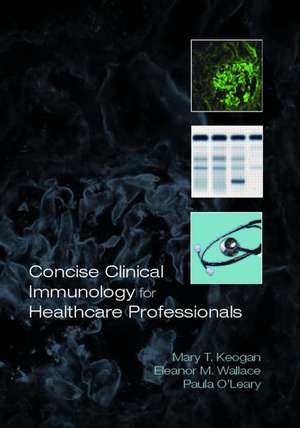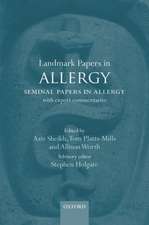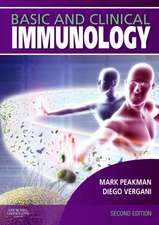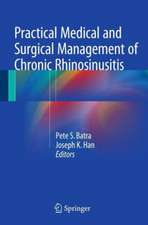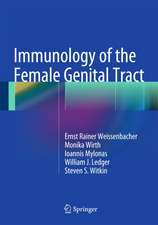Concise Clinical Immunology for Healthcare Professionals
Autor Mary Keogan, Eleanor M. Wallace, Paula O'Learyen Limba Engleză Paperback – 9 mar 2006
- essential basic immunology
- clinical immunology
- laboratory investigations of immunological disorders
- treatments used in immunological disorders.
| Toate formatele și edițiile | Preț | Express |
|---|---|---|
| Paperback (1) | 311.97 lei 6-8 săpt. | |
| Taylor & Francis – 9 mar 2006 | 311.97 lei 6-8 săpt. | |
| Hardback (1) | 979.35 lei 6-8 săpt. | |
| Taylor & Francis – 9 mar 2006 | 979.35 lei 6-8 săpt. |
Preț: 311.97 lei
Preț vechi: 413.23 lei
-25% Nou
Puncte Express: 468
Preț estimativ în valută:
59.71€ • 64.88$ • 50.19£
59.71€ • 64.88$ • 50.19£
Carte tipărită la comandă
Livrare economică 22 aprilie-06 mai
Preluare comenzi: 021 569.72.76
Specificații
ISBN-13: 9780415298308
ISBN-10: 041529830X
Pagini: 454
Ilustrații: 47 tables and 115 color line drawings
Dimensiuni: 174 x 246 x 21 mm
Greutate: 0.91 kg
Ediția:1
Editura: Taylor & Francis
Colecția Routledge
Locul publicării:Oxford, United Kingdom
ISBN-10: 041529830X
Pagini: 454
Ilustrații: 47 tables and 115 color line drawings
Dimensiuni: 174 x 246 x 21 mm
Greutate: 0.91 kg
Ediția:1
Editura: Taylor & Francis
Colecția Routledge
Locul publicării:Oxford, United Kingdom
Public țintă
Postgraduate and UndergraduateNotă biografică
Mary Keogan is Consultant Clinical Immunologist at Beaumont and Mater Misericordiae Hospitals, Dublin and Senior Lecturer in Pathology, Royal College of Surgeons in Ireland. Eleanor Wallace is Medical Scientist in the Department of Immunology, Beaumont Hospital, Dublin. Paula O’Leary is Senior Tutor in the Department of Medicine, Cork University Hospital, Ireland.
Cuprins
Basic Immunology 1.1. Introduction 1.2. Overview of Defence Mechanisms 1.3 Cells and Organs of the immune system 1.4. Innate Immune responses I - Phagocytosis and NK cells 1.5. Innate Immune responses II - Complement 1.6. Innate Immune responses III - Other soluble factors 1.7. Inflammation 1.8. What the immune system recognises 1.9. How does the immune system see antigen? 1.10. Lymphocyte Maturation 1.11. Immunoglobin structure 1.12. B cell activation 1.13. Immunoglobin functions Self-assessment Questions 1.14. HLA molecules 1.15. TCR and Immune repertoire 1.16. Antigen presentation 1.17. Helper T cell activation 1.18. Cytotoxic T cells 1.19. Initiation of Immune response 1.20. Maintenance of the Immune response 1.21. Control of the Immune response 1.22. Ontogeny of the Immune response 1.23. Immune responses to infection 1.24.How organisms evade the immune system 1.25. Consequences of Immune response 1.26. Host defence against tumours 1.27. Overview of Autoimmunity 1.28. Allergy Self-assessment Questions Clinical Immunology 2.1. Hypersensitivity Diseases 2.2. Atopy 2.3. Asthma 2.4. Urticaria and Angioedema 2.5. Food allergy and intolerance 2.6 Anaphylaxis 2.7 Other types of Hypersensitivity 2.8. Immunodeficiency 2.9. Defects in antibody - mediated immunity 2.10 Defects in T cell-mediated immunity 2.11. Defects of neutrophil number/function 2.12. Defects of complement function 2.13. HIV 2.14 Autoimmunity 2.15. Autoimmune Endocrinopathies 2.16. Autoimmune Haematological disorders 2.17. Autoimmune Liver disease 2.18. Immune mediated gastrointestinal disease 2.19. Immune mediated Neurological disease 2.20. Autoimmune Skin diseases 2.21. Immune mediated renal disease 2.22. Rheumatiod disease 2.23. Connective Tissue Disease 2.24. Vasculitides 2.25. Immune mediated tissue damage 2.26. Transplantation 2.27. Bone-marrow transplantation 2.28. Solid Organ Transplantation 2.29. Lymphoid Malignances 2.30. Leukaemia and Lymphoma 2.31. Plasma Cell Diseases Self-assessment Questions Immunotechniques and Diagnostic Tests used in Clinical Immunology 3.1. Laboratory tests in the clinical immunology laboratory 3.2. Antibodies are essential tools in The clinical immunology laboratory 3.3. Detection of antibodies or antigen 3.4. Non-organ specific autoimmunity 3.5 Organ specific autoimmunity 3.6. Measurement of the Acute Phase response 3.7. Complement 3.8. Immunodeficiency 3.9. Abnormal immunoglobulins 3.10. Angioedema: C1-Inhibitor levels and function 3.11. Allergy and hypersensitivity 3.12. Transplantation 3.13. Immunophenotyping leukamias and lymphomas 3.14. Direct Immunofluorescence on Tissue Biopsies Self-assessment Questions Treatment of Immunological Disorders 4.1. Principles of Immunosuppression 4.2. Corticosteroids 4.3. Immunosuppression (I) 4.4. Immunosuppression (II) 4.5. Therapeutic antibody production 4.6. Targeted cell depletion 4.7. Other antibody therapies 4.8. Intravenous immunoglobulin Replacement 4.9. High Dose IVIg 4.10. Cytokine therapy 4.11. Vaccination 4.12. Removal of antibody - Plasmapheresis 4.13. Management of allergic reactions Self-assessment Questions
Descriere
This text focuses on clinical problems seen in practice. It includes self-assessment questions and case histories to aid learning and understanding.
